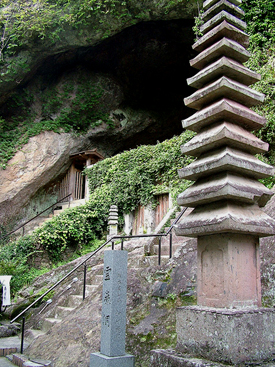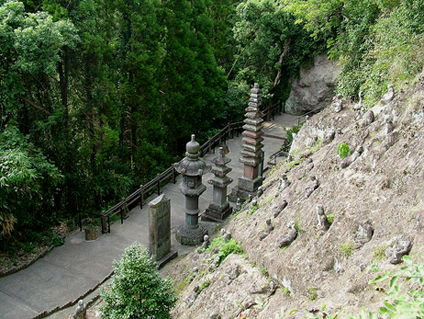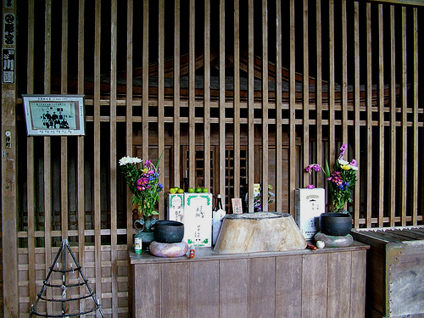It should be understood that the Niten Ichiryu is solely devoted to the understanding the Hyoho of Miyamoto Musashi, his philosophy and that of the present Soke, Imai Masayuki and his successor Iwami Toshio. Also the name of the ryu is the intellectual copyright of the present Soke and his successor.
Niten Ichiryu means Two Heavens as One School. This relates to Kannon, Goddess of mercy and Fudo Myo: He converts anger into salvation. Fudo seeks to frighten people into accepting the teachings of Dainichi and carries kurikara the devil-subduing sword in right hand that represents wisdom cutting through ignorance. Often seen seated or standing on rock because he is immovable in his faith. Both are protectors of Buddha and the God's that Musashi particularly liked.
This is the meaning as far a Niten Ichiryu is concerned. Japanese has Onyomi and Kunyomi (two readings) So it's possible to use the same kanji and get two, even more meanings. Even more in English as it is so ambiguous in translation. That's why Kendo as in shinai kendo can relate in Kanji to Shinkendo (new sword way) or is pronounced Todo when it relates to Batto waza. Lots of configurations.
In Japanese Ni usually means, two, in, by, etc. in everyday life. Ten is has never and will never be read sword. In Japan they study Japanese and Koten (Classical Japanese) related to Chinese to help them have a better meaning of the language. A lot of this a way beyond the normal understanding of Japanese people and needs an explanation with each word as I have written.
 |
With the ever increasing misrepresentation, published literature and videos making a connection with the Hyoho Niten Ichiryu and relating it such things like Kendo that was invented in the latter half of the Edo Era (beginning of the 19th Century). The following information might clear up a few misconceptions of anyone thinking there might be some relationship. This site is merely a guideline about the ryu and of course does not go into absolute detail about the finer points of technique. This is of course for the dojo. There are also now quite a few books on the market that relate the history of Musashi. Although translations are taken from the twenty four or more manuscripts that still exist, differences are made in translation even down to the type of weapons used in Musashi's many duels. But there are certain distinct similarities made which help us form a picture of the man, and his philosophy. The Entrance to Reigando - Alexander Bradshaw 2005 |
Repeated reading of Musashi's texts of Dokkodo and Gorin no Sho are also essential. It must be clearly understood that scrolls such as Gorin no Sho are clearly ambiguous, even more so when translated into English. This is why we find so many translations. Therefore to take particular quotes for granted would be just one particular view and perhaps not based on practical experience within the ryu. The Hyoho Niten Ichiryu is a living tradition handed down through generations. Reading and studying is of course essential but is merely an addition to ones practice.
In the more settled Edo period (1603 - 1867) the Takkakaw Shoguns, or military rulers encouraged the samurai to study martial arts to maintain peace. During this period the aims of martial arts at this time changed under the influence of Buddhism and Confucianism coming to emphasis the development of good character. The goal of study shifted from preparing the body for the battlefield to cultivating mental discipline. What remains of this Niten Ichiryu today is hard practice and the occasional demonstration. Sparring or the use of live blades went out during Musashi's lifetime and are not promulgated by the ryu. Most forms of Budo is described by Nippon Budokan and Japan's experts as Budo Bunka (Budo Culture) and now exists for educational purposes of the group and individuals.
Musashi did not like brashness and displays of importance, he thought they were both pretentious and vulgar. History shows him fighting people that showed arrogance. Then later in life a will to defend and frustrate an opponent rather than attack. This goes along with the teachings of the ryu. A transformation from Setsunin to Katsunin in times of war and conflict. He seemed to prefer a simple life with no desire for profit of worldly goods. We can't all live in caves these days but can at least try to excel in the dojo with practice and in embu showing our ability in experience rather than make claims of certification and importance. There was no one before Musashi, there will be no one to follow him. We can only hope to get a step nearer by following his teachings that are handed down as taught by his successors. He might have been able to make his own way. We as mere humans that have generally never experienced such conflict would be indeed stupid to think we could do the same. Like any other Budo HNIR is a lifetimes work and not a thing we can pick up from a few power trips.
 |
Any references elsewhere to Niten Ichiryu being connected to kendo, business, commercial enterprise, products, television, movie productions or books are for commercial gain or are delusional and could result in legal action as could any production of literature, photographs or recorded videos of any Niten Ichiryu demonstrations sold for financial gain. In reading Gorin no Sho or watching fictitious works on the life of Musashi some people may possibly identify with it in some particular aspect. Needless to say one can not do "Budo from books."
Looking down to the path to Reigando - Bradshaw 2005 |
The ryu is an oral/practical tradition handed down in its entirety through a selected line of headmasters with addition to literature. Notwithstanding certain students of students have also chose to make their own separate paths. In a democratic society anyone is free to do as they please and this does not lessen the fact that the present generation head and certain selected members of the ryu are clearly recognized by Nihon Kobudo Kyokai in affiliation with Nippon Budokan and the Nihon Kobudo Shinkokai.
There seems to be an ever increasing connection being made with "Nito Kendo" and Musashi. His philosophy as set out here and the actual practical methods and above all his philosophy bear no relationship to the concept of Kendo whatsoever, invented the latter part of the 1800's. The present Soke is also a Kendo teacher but has never picked up a shinai in Niten Ichiryu practice or tried to mix the Ryu's techniques with Kendo. The Shinai was "not invented" in Musashi's time. The short sword being held in the left hand goes along with the concept of using Jutte and sword. Holding a long sword in the left hand, short in the right was known as "Gyaku Nito". It offered the ability to be able to throw a shorter weapon with the right. But it is said that Musashi as an accomplished warrior could throw equally with both left and right.
To try and add a bit for those that have just started to read Gorin no Sho or have heard about Musashi: It is a “one sword style” requiring many years of fundamental practice. When we have truly learned the basics we can hopefully go on to Okuden Waza. This starts with the well known Nito Seiho with two weapons. Above this and even harder are is Kodachi Waza, Bo, Jutte and Jujitsu methods of dealing unarmed with an armed opponent. To use more than one weapon would be clearly trying to run before one can walk, two sword work simply a set of dance movements.
I object to anyone publishing part contents of these pages without permission. Surfing around I find plagiarized work. People claiming it's their own just because they made a few grammatical changes and revamped photographs from Europe to South America. It all has copyright. Don't copy it! Hyoho Niten Ichiryu/Niten Ichiryu work is owned and done solely by me most of the text translations from Imai Masayuki Soke - Iwami Toshio Soke. Any direct link to us by adding published material, commercials, product names, videos or graphics of Hyoho Niten Ichiryu demonstrations to ones own ideas would be a flagrant misrepresentation. At this time the ryu has no intentions of publishing any books or videos with exception of private use of its members. Sorry its long but a lot of these points seem to crop up a lot.
We have study groups and people practicing in other countries. Anyone wishing to obtain further details on this should contact me directly.
 |
© Hyakutake-Watkin 2015 - Imai Masayuki : Iwata Norikazu 2003